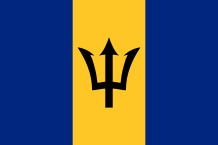BARBADOS
 Barbados is located at 160 km east of the Lesser Antilles’ arc. Its area is 431 sq km. Its soil is composed of coral put on sediment. Barbados is rather flat and its highest summit, Mont Hillaby, is 340m. During the colonization, an important part of the Barbadian forest was destroyed for sugar cane plantations. Today, there are some groups of trees in places very steep. Among these trees, there are the fig tree (Ficus Citrofolia), the casuarina, the carob tree, the poinciana or the mahogany. About the wildlife, there are, for example, the green monkey – native of West Africa – which was brought in the island as domestic animal, the hare, mangoose, snake, bat and many species of bird (egret, blackbird, heron, hummingbird…).
Barbados is located at 160 km east of the Lesser Antilles’ arc. Its area is 431 sq km. Its soil is composed of coral put on sediment. Barbados is rather flat and its highest summit, Mont Hillaby, is 340m. During the colonization, an important part of the Barbadian forest was destroyed for sugar cane plantations. Today, there are some groups of trees in places very steep. Among these trees, there are the fig tree (Ficus Citrofolia), the casuarina, the carob tree, the poinciana or the mahogany. About the wildlife, there are, for example, the green monkey – native of West Africa – which was brought in the island as domestic animal, the hare, mangoose, snake, bat and many species of bird (egret, blackbird, heron, hummingbird…).
About the economy, since the 1970s, tourism became the first activity instead of sugar. Fishing, clothes factories, products of pharmacy, computers components, natural gas production also form the economy.
Barbados’ first inhabitants were the Arawak Indians. The Carib Indians killed them or chased them out around 1200 BC. When the Spanish arrived in the island in the early 1500s, the Caribs were not present ; may be they ran away before… In 1536, when Pedro O Campos (the Portuguese explorer) went to Brazil, he stoped in the island and named it “Los Barbados” (Bearded ones) probably because of the long aerial roots of the numerous fig trees. In 1625, Captain John Powell claimed the island for Great Britain. In 1627, his brother, Captain Henri Powell arrived in Barbados with 80 settlers and 10 slaves. The first colony settled in Jamestown, today Holetown. Next year, the British settlers were 2000 in Barbados to grow tabacco and cotton then, in the 1640s, sugar cane. The importation of African slaves developed. Some of the largest plantations in the West Indies were founded in Barbados. Because of its geographical location, the island did not suffer from the war between French and English that raged in that period.
In 1639, Barbados’ landowners set up a legislative assembly. During the civil war in Great Britain, Barbados stayed faithful to the Monarchy. After the execution of King Charles I in 1649, Oliver Cromwell sent soldiers to the island, in 1651, to establish his authority. Next year, Barbados signed the Articles of Surrender – foundation of Barbados’ Charter – which guaranteed the presence of a governor and an elected assembly in the island. When the monarchy was restored, in 1660, that charter gave more independence to Barbados than to other British colonies.
In 1834, when slavery was abolished, many ex slaves continued working in the plantations. After the 1929 economic crisis, the unemployement appeared and riots broke out in Barbados. England created the British Colonial Welfare and the Development Office and gave more political responsabilities to Black people.
In 1951, the universal suffrage was instituted and, in 1961, the island set up its own government. On November 30, 1966, Barbados became an independent state led by a Prime Minister. The country is member of the Commonwealth.
Area : 431 sq km (167 sq miles)
Population : 290 000 inhabitants
Capital : Bridgetown
Language : English
Currency : Barbados Dollar (B$)
People : Barbadians
